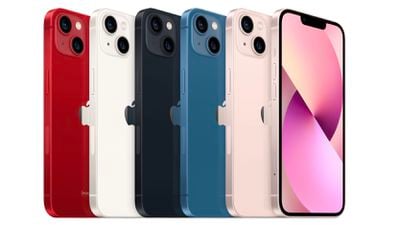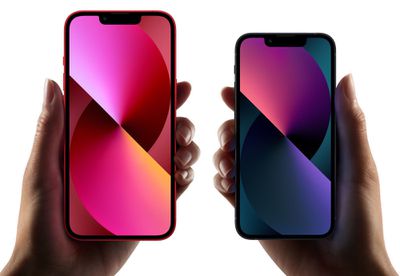At a Glance
- Apple's newest iPhones with updated cameras, new colors, smaller notches, and faster A15 chip. Launched September 24, 2021.
Features
- 5.4 and 6.1-inch sizes
- Similar to iPhone 12 lineup
- Smaller notch
- New colors
- Camera improvements
- A15 Chip
- 5G
- Pre-order September 17
The iPhone 13 and iPhone 13 mini
Introduced on September 14, 2021, the iPhone 13 and iPhone 13 mini are Apple's newest flagship iPhones at the more affordable end, and are being sold alongside the more expensive iPhone 13 Pro and iPhone 13 Pro Max. The iPhone 13 and iPhone 13 mini are ideal for those who don't need pro-level camera features.
The 5.4-inch iPhone 13 mini is the successor to the iPhone 12 mini, while the 6.1-inch iPhone 13 is the replacement for the iPhone 12. Both of the new iPhone 13 models are nearly identical in design to the iPhone 12 models, featuring flat edges, an aerospace-grade aluminum enclosure, a glass back, and a slight increase in thickness (7.65mm). The iPhone 13 models are available in Pink, Blue, Midnight (black), Starlight (silver/gold), and (PRODUCT)RED.
Both of the new models feature Super Retina XDR Displays that are 28 percent brighter. The iPhone 13 mini has a 2340x1080 resolution with 476 pixels per inch, while the iPhone 13 has a 2532x1170The front-facing TrueDepth camera system has been updated and the Face ID notch is now smaller, taking up less overall space. Like last year's models, the iPhone 13 and 13 mini feature a Ceramic Shield cover glass that is infused with nano-ceramic crystals for better protection from drops. IP68 water and dust resistance is included, and the new iPhones can hold up to submersion in 6 meters of water for up to 30 minutes.
An upgraded A15 Bionic Chip powers the new iPhones. It features a 6-core CPU with 2 performance cores and 4 efficiency cores, a 4-core GPU (one less GPU core than the Pro models), and a 16-core Neural Engine.
There's a new diagonal dual-lens rear camera with 12 megapixel Wide and Ultra Wide cameras. The Wide camera features an improved f/1.6 aperture that lets in 47 percent more light and Sensor-Shift Stabilization, while the Ultra Wide camera features an improved f/2.4 aperture for improved low light performance.
Along with the standard Portrait Mode, Night Mode, Time-Lapse and other photographic capabilities, the iPhone 13 models gain Cinematic Mode, a feature that uses rack focus to seamlessly shift focus from one subject to another, artfully blurring the background and creating movie-quality depth effects. Cinematic mode shoots in Dolby HDR and the depth of field and blur can be adjusted using the iPhone's camera app. The iPhone 13 models also support 4K video recording at up to 60 fps.
Smart HDR 4 recognizes up to four people in a photo and optimizes contrast, lighting, and skin tones for each one, and Deep Fusion, a carry over from iPhone 12, activates in mid to low-light scenes to bring out texture and detail.
Photographic Styles are an upgraded kind of filter that applies selectively to an image, muting colors or boosting vividness without impacting skin tones. There are Vibrant, Rich Contrast, Warm, and Cool options, along with settings for Tone and Warmth for customization and refining.
Apple's iPhone 13 and 13 mini can be unlocked with the Face ID facial recognition system, which works with the 12-megapixel front-facing camera that supports Smart HDR 4, Deep Fusion, Night Mode, Cinematic Mode, Night Mode Selfies, and more.
5G connectivity is included for better quality video streaming, higher-definition FaceTime calls, and improved gaming, but the super fast mmWave speeds are again limited to major cities in the United States. Slower sub-6GHz 5G speeds are available in more rural areas in the U.S. and in other countries, and there's support for more 5G bands for 5G connectivity in more places.
The iPhone 13 and 13 mini support Wi-Fi 6 and Bluetooth 5.0, plus they include a U1 Ultra Wideband chip for spatial awareness.
Gigabit LTE is supported when 5G isn't available, and to preserve battery life when using 5G, a Smart Data Mode reverts to an LTE connection when 5G speeds aren't necessary. The new iPhone 13 models offer dual eSIM support and don't come with a physical SIM by default, but there's still a nano-SIM slot.

Battery life has improved significantly thanks to larger batteries and the more efficient A15 chip. The iPhone 13 mini offers up to 1.5 hours more battery life than the iPhone 12 mini, and the iPhone 13 offers up to 2.5 hours more battery life than the iPhone 12.
Storage space starts at 128GB and goes up to 512GB at the high end. There's a built-in three-axis gyro, an accelerometer, proximity sensor, ambient light sensor, and barometer.

Like last year's iPhones, the iPhone 13 and iPhone 13 mini have built-in magnets and are compatible with MagSafe accessories, charging at up to 15W with Apple's MagSafe Charger. The iPhones also support fast charging, which provides 50 percent charge in 30 minutes with a 20W power adapter.
There is no power adapter or EarPods included with the iPhone 13 and 13 mini, and these accessories must be purchased separately. They do ship with a USB-C to Lightning cable for charging purposes.
Pricing and Availability
Pricing on the iPhone 13 mini starts at $699, while pricing on the iPhone 13 starts at $799, and there were no increases in prices in 2021. Pre-orders for the new iPhone 13 models started on Friday, September 17 at 5:00 a.m. Pacific Time, with the first devices arriving to customers on Friday, September 24.
Reviews:
Reviewers have been impressed with the iPhone 13's battery life improvements, but generally felt that it is only an iterative refresh over last year's iPhone 12.
The Verge's Dieter Bohn said that battery life this year is "excellent," pointing to real-world tests. On the smaller iPhone 13 mini, Engadget said that while it is improved, it is "still shorter than the average smartphone."
With regard to the camera, Bohn said that "details are sharp and accurate, colors are rich without being oversaturated, focusing is fast and reliable, portrait mode is good enough to use day to day, and low light and night sight are both exceptional." The Wall Street Journal's Joanna Stern says that while the camera improvements with the iPhone 13 are welcome, they alone are not sufficient enough to convince an iPhone 12 user to upgrade.
CNET said that performance and battery life are solid and that the iPhone 13 will be a reliable option for the majority of people.
Courtesy: MacRumors Staff
No comments:
Post a Comment